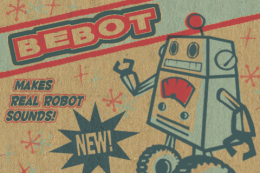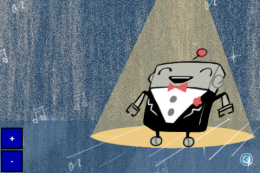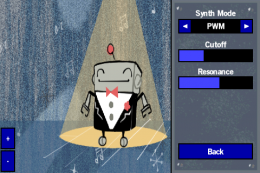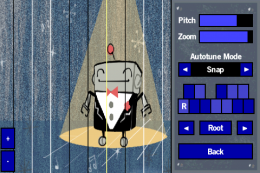
s Bebot (iTunes link) was the first app I downloaded when I got my iPod touch back in the day, and it’s one of only a handful of apps that made the transition to my iPhone 4. It is described by developers Normalware as “Part robot, part synth” and seems at first glance to be a fun toy, but a more in depth look reveals a pretty tasty synthesizer beneath a simple and intuitive interface.
Bebot (iTunes link) was the first app I downloaded when I got my iPod touch back in the day, and it’s one of only a handful of apps that made the transition to my iPhone 4. It is described by developers Normalware as “Part robot, part synth” and seems at first glance to be a fun toy, but a more in depth look reveals a pretty tasty synthesizer beneath a simple and intuitive interface.
On launching Bebot you’re presented with a cute little retro looking robot which ‘sings’ as you move your fingers around the screen. This is instantly fun. He bends down to hit the low notes to the left of the screen and leans back to hit those highs to the right, and if you move your fingers vertically the filter opens up so that the sound really zings, positively encouraging you to put him through his paces. Kids love it and being a big kid myself, so do I.

A single tap on the plus or minus icons to the bottom left of the screen shifts you up or down an octave at a time. Double tapping the icon on the bottom right of the screen opens a menu and it’s here you realise what lies beneath the surface of this little app.
There are some splendid sounding presets in here, but if you fancy creating your own sound there are four different oscillator types available with some simple controls to sculpt the sound, in addition to an effects section with echo, overdrive and chorus controls. It’s a pretty straightforward process which makes it a cinch to create a screaming lead synth sound, a nice mellow string sound, or almost anything in between.

In order to make sure your newly minted synth masterpiece sounds as awesome as possible when you play it, Bebot gives you a selection of scales to lock to. If you turn the note grid on, the app overlays a series of coloured vertical lines. Yellow lines represent a whole octave from the next nearest yellow line and the black and white lines correspond to the black and white keys within the scale, in the style of a piano keyboard. You can also put together your own scale very easily and adjust whether the app slides or snaps to the next note. Lastly, you have a ‘zoom’ slider which adjusts the density of notes when you play.

This all means you can’t hit a bum note. I like that. A lot.
I can’t fault Bebot really – it’d be nice to be able to save a performance as an audio file, and perhaps have a couple more types of synthesis available but it’s not a deal breaker. Sure, there are plenty of other far more comprehensive sound synthesis apps available these days, but Bebot already has everything it needs to keep me coming back for more of its robotic synthy goodness.
Get the TNW newsletter
Get the most important tech news in your inbox each week.





